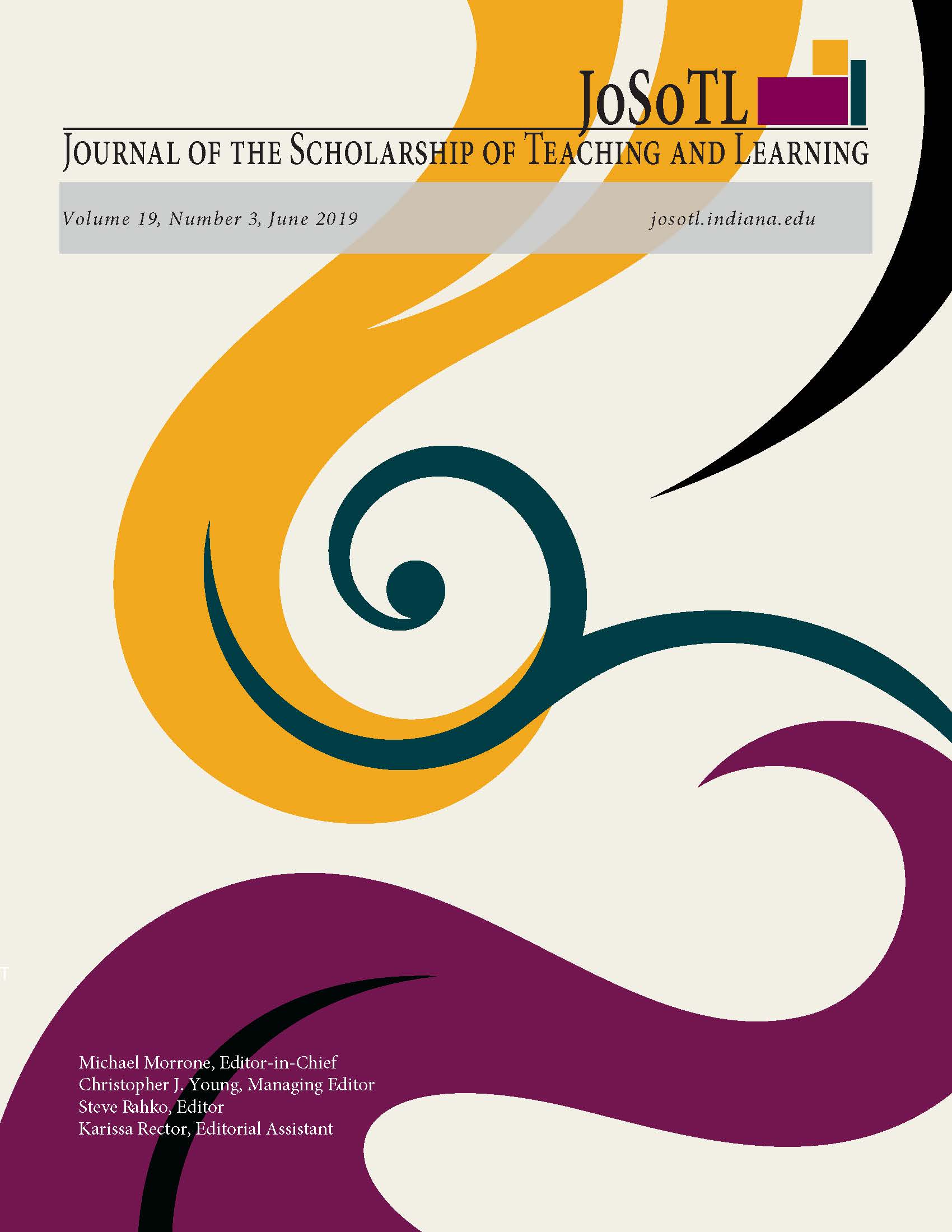Improving Critical Reading with E-Texts: A Controlled Study in a Collegiate Philosophy Course
Main Article Content
Abstract
Downloads
Article Details
- Authors retain copyright and grant the Journal of the Scholarship of Teaching and Learning (JoSoTL) right of first publication with the work simultaneously licensed under a Creative Commons Attribution License, (CC-BY) 4.0 International, allowing others to share the work with proper acknowledgement and citation of the work's authorship and initial publication in the Journal of the Scholarship of Teaching and Learning.
- Authors are able to enter separate, additional contractual agreements for the non-exclusive distribution of the journal's published version of the work (e.g., post it to an institutional repository or publish it in a book), with an acknowledgement of its initial publication in the Journal of the Scholarship of Teaching and Learning.
- In pursuit of manuscripts of the highest quality, multiple opportunities for mentoring, and greater reach and citation of JoSoTL publications, JoSoTL encourages authors to share their drafts to seek feedback from relevant communities unless the manuscript is already under review or in the publication queue after being accepted. In other words, to be eligible for publication in JoSoTL, manuscripts should not be shared publicly (e.g., online), while under review (after being initially submitted, or after being revised and resubmitted for reconsideration), or upon notice of acceptance and before publication. Once published, authors are strongly encouraged to share the published version widely, with an acknowledgement of its initial publication in the Journal of the Scholarship of Teaching and Learning.
References
ACT Inc. (2007). Aligning Postsecondary Expectations and High School Practice: The Gap Defined Policy Implications of the ACT National Curriculum Survey® Results. Washington, DC: ACT, Inc.
Available online at http://www.act.org/ path/policy/pdf/NCSPolicyBrief.pdf Baron, N. (2015). Words Onscreen: The Fate of Reading in a Digital World. New York: Oxford University Press.
Baron, N., Calixte, R., Havewala, M. (2017). “The persistence of print among university students: an exploratory study. Telematics and Informatics. 34 (5), 590-604.
Dahl, R. (2000). On Democracy. New Haven Connecticut: Yale Nota Bene.
Daniel, D. & Woody, W. (2013). “E-Textbooks at what cost? Performance and use of electronic v. print texts. Computers & Education. 62, 18-23.
Dennis, A. (2011). E-textbooks at Indiana University: a summary of two years of research. http://crg.iupui.edu/Portals/133/PropertyAgent/15158/Files/367/e-TextbooksatIU.pdf (accessed June 16, 2017).
Dennis, A.,, Morrone, A., Plaskoff, J., & McNamara, K. (2015). “Improving Learning with ETextbooks.” System Sciences: 48th Hawaii International Conference on System Sciences, IEEE Computer Society, 5253-5259.
Dennis, A., Abaci, S., Morrone, A., Plaskoff, J., & McNamara, K. (2016). “Effects of e-textbook instructor annotations on learner performance.” Journal of Computing in Higher Education. 28(2), 221-235.
Dirda, M. (2015). Browsings. New York: Pegasus Books.
Foasberg, N. (2014). “Student reading practices in print and electronic media.” College & Research Libraries, 75(5), 705-723.
Hobson, E., (2004). “Getting Students to Read: 14 Tips.” Idea Paper 40. https://www.ideaedu.org/Portals/0/Uploads/Documents/IDEA%20Papers/IDEA%20Pa pers/Idea_Paper_40.pdf (accessed September 26, 2017).
Jabr, F. (2013). “The reading brain in the digital age: the science of paper versus screens. Scientific American. April 11. https://www.scientificamerican.com/article/reading-paper-screens/ (accessed June 16, 2017).
Jensen, M. & Scharff, L. (2014). “Using e-book annotations to develop deep reading.” Journal of Teaching and Learning with Technology. 3( 2), 83-86.
Klinkenborg, V. (2010). “Some Thoughts About E-Reading.” New York Times, April 15th, p. A26. http://www.nytimes.com/2010/04/15/opinion/15thu4.html (accessed June 16, 2017).
Levy, L. (2014). “7 Ways to Deal with Digital Distractions in Class.” Edudemic: Connecting Education and Technology. http://www.edudemic.com/7-ways-deal-digital-distractions/ (accessed September 12, 2017).
McCoy, B. (2013). “Digital Distractions in the Classroom: Student Classroom Use of Digital Devices for Non-Class Related Purposes.” Journal of Media Education. 4(4), 5-14.
Nussbaum, M. (2006). “Education and Democratic Citzenship,” Journal of Human Development. 7(3), 385-395.
Scharff, L. & Dull, C. (2011). Multiple Case Study Investigation of E-reader Devices in Academia; unpublished.
Singer, L., Alexander, P., (2016). “Reading Across Mediums: Effects of Reading Digital and Print Texts on Comprehension and Calibration.” Journal of Experimental Education. 85(1), 155-172.
Singer, L., Alexander, P., (2017). “Reading on Paper and Digitally: What the Past Decades of Empirical Research Reveal.” Review of Educational Research. 87(6), 1007-1041.
Tanner, M. (2014). Digital vs. print: Reading comprehension and the future of the book. SLIS Student Research Journal, 4(2). Retrieved from http://scholarworks.sjsu.edu/slissrj/vol4/iss2/6
Wolf, M, (2010). “Our ‘Deep Reading’ Brain: its digital evolution poses questions,” Nieman Reports. http://niemanreports.org/articles/our-deep-reading-brain-its-digital-evolution-posesquestions/ (accessed June 7, 2017).
Wolf, M. & Barzillai, M. (2009). “The Importance of Deep Reading.” Educational Leadership. 66(6), 32-37.
Woody, W., Daniel, D., & Baker, C. (2010). “E-books or textbooks: Students prefer textbooks.” Computers & Education. 55(3), 945-948.
